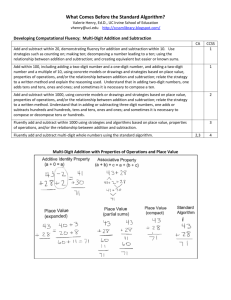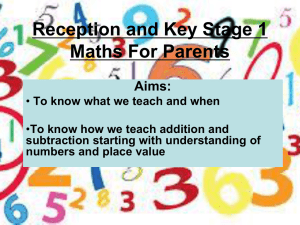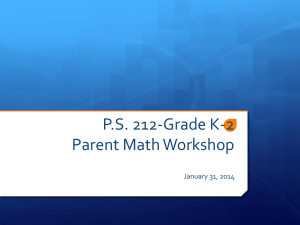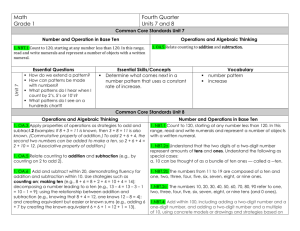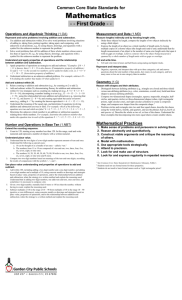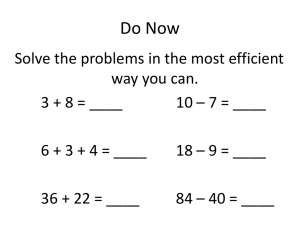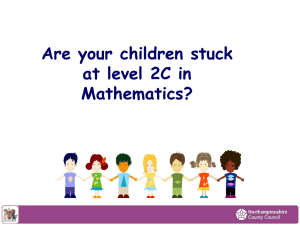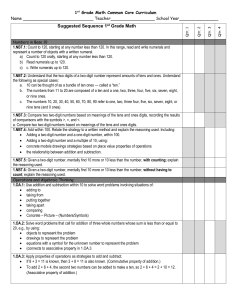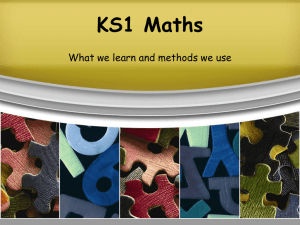Instructional Model of Two-Digit Numbers
advertisement
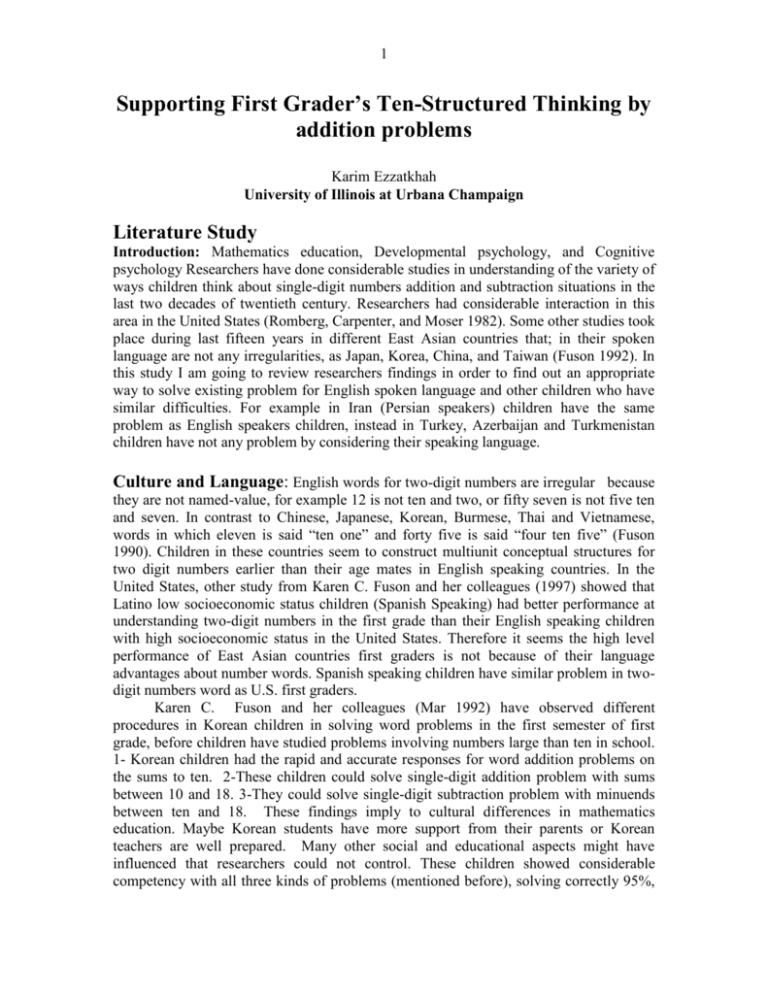
1 Supporting First Grader’s Ten-Structured Thinking by addition problems Karim Ezzatkhah University of Illinois at Urbana Champaign Literature Study Introduction: Mathematics education, Developmental psychology, and Cognitive psychology Researchers have done considerable studies in understanding of the variety of ways children think about single-digit numbers addition and subtraction situations in the last two decades of twentieth century. Researchers had considerable interaction in this area in the United States (Romberg, Carpenter, and Moser 1982). Some other studies took place during last fifteen years in different East Asian countries that; in their spoken language are not any irregularities, as Japan, Korea, China, and Taiwan (Fuson 1992). In this study I am going to review researchers findings in order to find out an appropriate way to solve existing problem for English spoken language and other children who have similar difficulties. For example in Iran (Persian speakers) children have the same problem as English speakers children, instead in Turkey, Azerbaijan and Turkmenistan children have not any problem by considering their speaking language. Culture and Language: English words for two-digit numbers are irregular because they are not named-value, for example 12 is not ten and two, or fifty seven is not five ten and seven. In contrast to Chinese, Japanese, Korean, Burmese, Thai and Vietnamese, words in which eleven is said “ten one” and forty five is said “four ten five” (Fuson 1990). Children in these countries seem to construct multiunit conceptual structures for two digit numbers earlier than their age mates in English speaking countries. In the United States, other study from Karen C. Fuson and her colleagues (1997) showed that Latino low socioeconomic status children (Spanish Speaking) had better performance at understanding two-digit numbers in the first grade than their English speaking children with high socioeconomic status in the United States. Therefore it seems the high level performance of East Asian countries first graders is not because of their language advantages about number words. Spanish speaking children have similar problem in twodigit numbers word as U.S. first graders. Karen C. Fuson and her colleagues (Mar 1992) have observed different procedures in Korean children in solving word problems in the first semester of first grade, before children have studied problems involving numbers large than ten in school. 1- Korean children had the rapid and accurate responses for word addition problems on the sums to ten. 2-These children could solve single-digit addition problem with sums between 10 and 18. 3-They could solve single-digit subtraction problem with minuends between ten and 18. These findings imply to cultural differences in mathematics education. Maybe Korean students have more support from their parents or Korean teachers are well prepared. Many other social and educational aspects might have influenced that researchers could not control. These children showed considerable competency with all three kinds of problems (mentioned before), solving correctly 95%, 2 85% and 75% of these problems respectively. Almost two third of the solution of the problems above ten were addition and subtraction decomposition methods structured around ten or known facts. Koran children did not have difficulty in two-digit numbers between ten and nineteen as English speaker students. In Korean language eleven is ten and one or twelve is ten and two. Language structure: In most East Asian countries languages are structured around baseten system instead in English speaker countries, as U.S.A. is not. For example, in Chinese, the number of 45 is four ten five and in English is called forty-five, that is not clear as well as Chinese. Researcher found that, Asian language number words might facilitate Asian children’s understanding of counting, number, and arithmetic (Miller & Stigler, 1987- Miura 1987-Fuson 1992). I think the Asian children also have a little difficulty, because when they call 36 as three ten six. It is possible to write 3106 instead of 36. Over all language is likely 0ne of the several factors in the large differences in mathematical achievement and development. Because Asian children outperform American children in other field of mathematics that presumably would not be influenced by the structure of number words. So, the structure of language is one of the many other reasons to better performance of Asian children (Stevenson, Stigler, Lee, Chen, 1990). Concrete modeling: Some researchers as Fuson (1992) argues that, Chinese, Japanese, and Korean first graders given base-ten longs (tens) and units (ones) make multiunit model, while American first graders model as units (unitary) not ten and ones (Miura, 1987). It is, because East Asian first graders work with tens and ones before attending school, but American student’s work after going to school with tens and ones (Miura 1987). Therefore, It depends on children’s learning experience, and it is possible overcome this problem in kindergarten for American children. Fuson (1992) argues that, children in Asian countries are familiar with metric system and abacus. These familiarities facilitate understanding number base-ten structure and place-value; instead American children have not such experience. I think six years old children in Asian countries do not have experience with these devices, unless, they have been taught by parents or teachers in preschools and kindergartens. Thus, abacus and metric system may not be as cultural advantages. Teaching method: Teachers teach to East Asian first graders, when teaching single-digit addition and subtraction by derived fact strategy. They also teach decomposing strategy, when teaching single-digit additions. For example, in term of combining 5+6=, East Asian first graders decompose 6 to 5 and 1; then, they say five plus five is ten and one more or “ten one” (Fuson, Stigler, & Bartsch, 1988). American first graders have not been taught in the same method. Therefore the differences perhaps are due to teaching method, rather than other factors. Children counted quantity ability in different cultures: Counting is the method used in all cultures to differentiate and label quantities. So, children in each culture must learn some strategies to count quantities (Fuson, 1992). 1. Children have to learn number sequence in their own culture. 2. Children have to learn how to point usually to each member of collection in counting position in own culture. 3. Children have to learn indicating act to connect one number label to entire collection. 3 4. Children have to learn cardinal meaning in a collection (last label indicate the total number of the collection). 5. Children have to learn the methods of remembering already counted collection. The specific strategies used by children for solving addition and subtraction problems depend on the culture’s counting system. Addition by young children in the United States usually involves the counting of collections of objects (Steffe, Thompson & Richards, 1982). Researcher found that, Korean and Japanese children use the same strategy (Ginsberg, 1989). Children in two different cultures use one specific counting strategy. Children start object counting (cc) before coming to school, if objects are not available, then fingers are often used as a substitute (Siegler & Sherager, 1984). Finger counting has some limitations, for example when children want to solve the addition problem like: 8+9=? Using two addends with fingers in the same time is not possible. Therefore, using objects would give more flexibility to model concretely two addends and count the collections. Children understanding of basic arithmetic: Jean Piaget (1965) after a lot of experiments argued that children did not have a conceptual understanding of basic arithmetic until the age 6 to 8years old. Piaget has divided children ‘s cognitive development to four consecutive stages and he mentioned that children in third stage of thinking development are able to understand basic arithmetic operations. However, more recent studies, using different methods, showed that children have considerable knowledge of arithmetic before attending school even from early childhood (Starkey 1992; Gelman & Starkey 1982). Research on human infants demonstrated their ability to differentiate sets of one, two, and three objects from each other. This immediate apprehension and labeling of small numbers has been termed subitizing. (Starkey, 1992 & Wynn, 1992a). Children first cardinal meanings of number words are as labels for small sets of perceived objects. These perceptual quantity meanings seem to be biologically prepares (Fuson, 1992). Perceptual quantity provides an early basis to addition, ant it continues to play a role in the more advanced conceptual level of addition and subtraction (Jordan, Huttenlocher & Levine, 1992). Children by four and five years old rely on verbal counting to solve simple arithmetic problems (Resnick, 1983). The use of counting to solve arithmetic problems represents their informal knowledge, because children use these skills without formal instruction. The most important finding across all of these studies is that, children adapt their previous mathematical knowledge (counting skills) to situation that, require addition or subtraction (Geary, 1996). Most kindergartners in the U.S. have considerable experience by counting with a lot of variety of strategies (Gelman & Gallistel 1978). Karen Fuson (1990) is called to this children’s counting ability, counted quantity. Addition and Subtraction Situations in the Real world: There are a lot of studies about the kinds of word problems and whole number addition and subtraction situations in the real world. Most of researchers have found-out recently that, there are basically four addition and subtraction situations (Carpenter & Moser 1983, Fuson 1992). When there are two quantities, children can combine them or compare them. Fuson (1992) for combine and compare situations says Binary operations. When there is only one quantity; children can add to that quantity or take from that quantity. These two cases 4 have been called Unary operations. Distinguishing between two different operations that the first is active and the other is static situation is one of the children’s problems in first grades. Each addition and subtraction situation involves three quantities, any one of which can be unknown. For example in 4+3=7 (equation) children have two addends and they are obtaining the sum, in 6-2=4 (equation) children involve with first quantity and compare with second quantity to get differences, or take away 2 from 6 (first quantity) to find remainder. The symbols like +, - and = have different meaning in different situations (Geary1996). For example, (-) has compare and take away meanings in two different problem situation. Children’s counting strategies: Children in the United States pass five different levels of counting strategies during the development of counting strategy in early childhood. The last level of counting is numerical counting that children involve with abstract addition and subtraction (adding or subtracting symbols). In this level children know each number as a combination of small numbers. For example 6 can be (1&5), (2&4), (3&3), (4&2), and (5&1). They can also understand that, 7&4 can be 7&3&1, or 10&1. (Fuson, 1992). Researchers found that, children in the first grades have a lot of addition, subtraction, and counting experiences from out of school. Teachers who are ignoring these experiences, they create major problem to children who are eager to learn mathematics. This ignorance of children previous knowledge would be problematic for children in term of connecting their previous knowledge to new knowledge (school knowledge) that, teachers are willing to teach. Researchers could found many different counting strategies used by children when, they add collections. For example children for solving simple addition problem like 2+3 use five general classes of strategies (Carpenter and Moser, 1983). Using manipulative Finger counting Verbal counting (counting mentally) Derived facts counting (Derived fact strategy involves using memorized addition facts) Fact retrieval counting (Children quickly produce the answer, without overt signs of counting) Most of children in the United States examine those strategies in out of school at in their everyday life. Transition from one level to other is related to different factors, for example, transition from finger to verbal counting is primarily dependent on the child’s ability to mentally keep track of the numbers that have already be counted and those that still need to be counted, and for most children shift from one level to other level is gradual (Fuson, 1982). Children’s Difficulties in identifying digits of Multi-digit Number: Children in the United States receiving ordinary classroom instruction have considerable difficulties constructing concepts of multi-digit numeration, addition, and subtraction. The National Assessment of Educational Progress reported that, only 64% of third graders could identify the digit in the tens place in a four-digit number, and less than half identified the hundreds or thousands digit. This inability to understand or use multiunit concepts affects multi-digit number algorithms (Brown et al., 1989). 5 In a heterogeneous sample of fifth graders from the Chicago area, only 69% correctly solved a three-digit subtraction requiring two trades (Stigler & Stevenson, 1990). Many errors that U.S. children make on numeration and on multi-digit subtraction tasks indicate they interpret and treat multi-digit numbers, as single-digit numbers placed adjacent to each other, rather than using multi-digit meanings for the digits in different positions. Fuson (1990) has argued: “Thus, they seem to be using a concatenated singledigit conceptual structure for multi-digit numbers. The use of this concatenated singledigit meaning for multi-digit numbers may stem from classroom experiences that do not sufficiently support children’s construction of multiunit meanings, do require children to subtract multi-digit numbers in procedural rule-directed fashion, and do set expectations that school mathematics activities do not require one to think or to access meanings.” School textbooks present multi-digit numeration and subtraction in ways that interfere with children’s ability to make generalizations (Fuson, 1988). In the U.S.A. work on multi-digit addition and subtraction is distributed over four or five years, while in Asian countries and Russia such work is completed by the 3rd grade (Fuson 1990). Most previous work on children’s invented solutions has been limited to two-digit numbers. Many of these procedures do not generalize well to large numbers and/or they depend on special solutions for the decades. (Fuson, 1990) Baroody (1990) has emphasized that, “many children in the United States have difficulty learning place-value skills and concepts, and the teaching of these fundamental competencies needs to improve.” He also argued; “there is no clear answer that how much it takes time student understand multiunit concepts”. Currently research does not answer what concrete or pictorial models need to be used to construct a secure and deep multiunit concept (Resnick& Ford, 1981). Actually what we are going to teach in term of multi-digit unit and what extend student need the concepts and procedures. Is not clear. Instructional Materials: Educational researchers have shown a growing interest in examining children learning of mathematics in situations that involve the manipulation of physical objects and events (e.g.; Greeno1988). For example he has suggested that manipulating the physical referents of symbols helps engage children in “meaningful learning activities”. National council of Teachers of Mathematics (1998 Pp112) has emphasized: “Technology can help children develop number sense through computer manipulatives. For example students can break computer base-ten blocks into ones and glue ones together to forms tens. The computer also links the blocks to symbols and so forth”. Most researchers in the U.S.A use base-ten blocks as manipulatives. These manipulatives are not appropriate for first graders, because need measurement skills. For example first graders have to measure Long By Small Cubes and make sure that each long is ten Small Cubes. Some researchers as Fuson and her colleagues (1997) have used money as manipulatives to teach place-value concept. We should realize that money has its own value in any places and its value is not based on the place, which we are putting them. Therefore the best concrete objects are wooden or plastic sticks in ten centimeters size, that children can count-up and make groups of ten. In computer screen tally marks or countable objects are appropriate manipulatives to demonstrate two-digit numbers in place-value system. 6 Children Conceptual Structures for Two-Digit numbers: Developing conceptual structure of two-digit numbers depends on some factors: 1- the language that is used by the teacher and students and cultural issues. 2-The type of physical materials that are used. 3- the problems that are to be used. 4-The structure of the class activities. 5- the student’s cognitive development. These components concert with one another to support children construction of meanings at two-digit numbers. Through various projects Karen C. Fuson and her colleagues (1997) identified five different conceptions of two-digit numbers during their conceptual development of two-digit numbers “ unitary, decade, sequence, separate and integrated”. Children Initially have unitary conception of any discrete quantity. One…. Five ***** (Quantity) 1-9 Five (Number word) (number mark) 5 Figure 1-Unitary Single-Digit Children in the first grade have the same conceptual structure for big quantities. For example 15 is 1,2,3,……..14,15 units (Fuson1997). One,….fifteen ***** ***** ***** Fifteen 15 Figure 2- Unitary Multi-Digit This unitary multi-digit conceptual structure has to transit to separate Tens and Ones, then, sequence Tens and Ones and finally integrated separate-sequence Tens and Ones (Fuson1997). 7 One ten and five ones * * * * * * * * * * * * * * * One ten five ones 15 Or fifteen (the name 0f number) Figure 3- Multi-unit concept of two-digit number The main different between figure2 and figure3is that, children in the figure 3 have to learn: 1- counting the quantity, grouping by ten and ordering tens and ones from left to right. 2- Learning relationship between ordered quantity and English number word. 3- comprehending relationship between ordered quantity and symbols, that is in the same order. 4-Making relationship between English word and ordered symbols. These two figures consist some similar activities that students have learned before. Thus, this knowledge will help them to accommodate the new concept (multiunit conceptual structures) based on their previous information. Present Textbooks and Teaching/Learning Two-Digit Numbers: In the United States, elementary schools children learn two-digit numbers from second grade. Reading and writing two-digit numerals is initially based on multiunit conceptual structure. Children learn addition/subtraction of the most difficult single-digit sums between ten and eighteen (e.g.; 7+8=15 and 15-8=7) after learning two-digit number without trading as (56-21) and (34+23). These teaching and learning processes and a lot of difficulties that have been mentioned, has created existing problems in teaching and learning place-value system and addition subtraction problems in the early years of elementary schools. What is the problem? Many first graders in the U.S.A. do not understand the base-ten structure of multidigit number words (Fuson, 1990). U.S. students have problem with grouping quantities and understanding placevalue system (Miura, 1987). 8 There are irregularities in reading and writing two digit numbers. Thus, first graders need time and effective instruction to learn those numbers. Reading and writing multi-digit numbers is difficult for children because written numbers do not correspond directly with spoken counting numbers, for example fifteen is not one ten and five or thirty seven is not three tens and seven. Children’s counting knowledge from out of school is not like counting procedure that children learn at school. For example, children when count a collection, they get the result as a combination of ones (unitary concept), in fact we are expecting the result in base-ten system (multi-unit concept). ( Fuson, 1992). Place- value and base-ten knowledge Children initially do not realize that our number system is place-value system; the position of a digit determines its value. For example in written numbers as 5432, 3542, 3452, 2345, digit 5 represent different values by virtue of its position. Children come to school with a counting–based concept of numbers, and do not know about grouped items. For instance they look at 14 as 14 units, not one ten and four ones. So, children should discover, first the importance of grouping collections into larger units or multi-units concept. Second, children have to understand and examine grouping by ten and, ordering groups from right to left, and from smaller to larger groups. Third, children must reinvent place-value rules in written numbers. Fourth, nominating digits from left to right to read written numbers. Fifth, getting mastery in term of trading from larger digits to smaller and vice versa, for example they have to discover that, two tens and four can be represent as, one ten and fourteen ones, or twenty four ones. Therefore, children understanding of place-value and base ten system is necessary for some reasons: First, children understanding of the conceptual meaning of spoken and written multi-digit numbers is dependent the knowledge of base-ten system. Second, the understanding that multi-digit numbers represents groups of ones, tens and, ten times ten, and etc (Fuson, 1990). Instructional Model of Two-Digit Numbers: In Fuson’s model, children’s conceptual structure about single-digit numbers initially is unitary. They have to develop this model gradually to multiunit conceptual structure. She and her colleagues have suggested five different stages (unitary, decade, sequence, separate and integrated) in development processes (Fuson et, al 1997). We know children in the development processes have to accommodate the new knowledge that is based on their previous knowledge Piaget (1965). Therefore children would extend their Triad model Fuson (1997) to a different model as an instructional loop proposed in this project (Figure4). This model has different stages. The first stage contains 45 basic facts problems that, students will solve by their own strategies through a mathematical game. Students follow this instructional model by teacher’s guideline to transit from unitary conceptual level to multiunit conceptual level of thinking structure. 9 Single-digit addition, sums between ten and eighteen As (9+9) by appropriate manipulitives Conceptions of the quantity ****** ****** ****** English word (eighteen) Symbols (18) Unitary conception Counting on the quantity and grouping by ten Ordering from left to right and from bigger to smaller (Groups of tens and ones) * * * * * * * * * * * * * * * * * * Tens/Ones 1 8 18 Multiunit Mu conception Figure-4. A developmental sequence of conceptual structures for two-digit numbers 10 Purpose of this study It proposed, that the students those learn two-digit numbers by addition of the most difficult single-digit sums to 18, with unitary conceptual structures. And, they use appropriate manipulatives or computer to model the learning situation. These students will be able gradually acquire multiunit conceptual structures and understand two-digit numbers sense. They also learn difficult single-digit addition sums to 18, with a deep understanding. Therefore, their understanding of two-digit numbers and single-digit addition sums to 18, would be better than students that are following textbooks based instruction in this field. Methodology 1- Participants and settings: This project will take place in one of the Champaign-Urbana elementary public schools. All intact class students will participate in the project. First I will study student’s files to obtain certain information as: age, gender, socioeconomic status, cultural background and mathematics achievement tests (teacher made). If they had IQ scores or some similar information; It will be considered as one of the selection criterion. I will choose three identical classes, two classes will be experimental and a control groups. 2- Teachers training Three first grade teachers will participate in this study. The teachers who are teaching in experimental classes would have short term training to master the investigative approach and instructional model of this study (maximum 8 hours). Teachers would have a short training time about running on the preliminary test, pretest, posttest and also interviews (2 hours). Teachers training will be in four phases: Phase One: In this part teachers will be familiar with the preliminary test and testing strategies. I will emphasize to them to consider this knowledge as baseline, so they will be recommended to teach and complete student’s knowledge in these terms with their own strategies. So it will be possible to have remedial instruction after getting test results. In this phase teachers will be aware that their students in all three classes would have equal knowledge in understanding at number sense based on preliminary test content. Phase two: Before intervention all students will pass pretest. So, teachers would have a short period of time to be familiar with test and its administration. Phase Three :In this part, the experimental teachers who had training would learn about the intervention phase of the project, manipulatives and applying investigative approach in classroom activities practically. Only one experimental teacher will be trained to use Applet in her class. The other experimental teacher will be trained to teach with manipulatives. Phase four: In this phase of the training teachers will participate to be familiar with posttests and testing strategies. This orientation takes place only after intervention. 11 3-Design This study has been designed as three nonequivalent control group design with pretest, posttest and supplemented by interview. The treatment in this study is: (teaching via Instructional model of two digit numbers that, has been scheduled for this study). The experimental groups have treatment beside its traditional instruction; and they learn by two different concrete modeling (one class by computer assistant and other class by discrete materials). The control group has only traditional instruction. Length of one session mathematics class in first grade (one hour) in a day: 1- Traditional curriculum for control group 60 minutes 2-Traditional curriculum and treatment for experimental groups 40 minutes 20 minutes Table1shows the operational timeline of the research project at 21 school days. Diagram of nonequivalent control group design: Dependent variable O Students performance In pretest Treatment X Twenty teaching Sessions By computer Class B: Student performance In pretest Twenty Student performance teaching in posttest Sessions By Manipulative. Class C: Student performance In pretest Non Class A: Dependent Variable O Student performance in posttest Student performance in posttest 12 4-Experimental Procedure Preliminary test: preliminary test includes fifteen questions needs 30 minutes. The preliminary test will be administered in one session by teachers and will be scored by researcher. Each question has ten points. Preliminary test includes: 1-Counting skills: 1-1-Oral counting 1-2-Skip counting 1-3 Comparing quantities 2- Understanding the meaning of number: 2-1 Cardinal meaning 2-2 Ordinal meaning 2-3 Measurement meaning 2-4 Nominal meaning 3- Logical thinking Abilities: 3-1- Equal partitioning 3-2-Grouping 3-3-Ordering 3-4-Number Relationship 4- Number of 36 Single Digit Additions and 36 Subtractions Sum to Ten. 5- Number Literacy: 5-1-Numeral Recognition 5-2-Numeral Reading and writing Preliminary test for experimental and control groups include tests from all five categories (above mentioned). Students who can answer at least eighty percent of the tasks correctly, will be allow to participate in both experimental and control groups. Preexperimental instructional phase will conduct to make group’s prerequisite mathematics knowledge identical. Thus, Teachers may conduct or provide remedial instructions to meet the 80% criterion before experiment. Pretest &Posttest: Pretest includes ten questions and takes time at least twenty minutes and will administrate by teachers. Posttest has twenty questions (ten questions the same as pretest and ten more) and will administrate by teachers. Therefore pretest has fewer questions than posttest, but pretest’s questions are key questions about in all four domains as below. Each question in pretest has ten points and in posttest five points. 1- Evaluating student’s knowledge in solving Single-digit addition problems that sum-up to eighteen 2- Composing and decomposing two-digit number in first decade of number sequence and distinguishing between values of the digits and their order 3- Students understanding of the place-value system in writing two-digit numbers at the number sequence (prediction from tasks) 4- Producing other two-digit numbers more than 18, like19, 20,21…. etc. understanding that some numbers has different name (for example two tens is nominated twenty) 13 Interview: At least five students from each group will be interviewed by the teacher to figure out students’ strategies in solving single-digit addition problems and value of digits in two-digit number. The interview will take place in the classroom in an appropriate time. The interview consists at fixed closed ended questions for all participants from both experimental and control groups. The teachers may write down students’ answers or audiotape (in case of having parent’s permission). The researcher will do coding, quantifying and interpreting students’ answers. The main question of the interview would be:(How do you come-up to this answer). The teacher will ask the question by showing student’s worksheet at pretest and posttest. Manipulatives: This project is designed to work with two different manipulatives. First will be concrete objects as: 1- 100 wooden or plastic sticks. Tens Ones 2-Rubber bands. 3- a piece of paper illustrated the place-value mat. Second by computer assisted program: URL to computer program is: (http://www.mste.uiuc.edu/users/mmckelve/applets/Counting/done/counting.html). Treatment: The experimental and control classes will continue their normal instructions. The experimental groups have new instruction procedure beyond their everyday mathematics courses. This instruction includes learning 45 single-digit addition problems (Figure 6) and regrouping the results as ten’s and ones (Figure 7) by concrete modeling (discrete objects or computer assisted). Process of the treatment: The instruction will take place during sixteen short sessions and each session will be only twenty minutes (Table 1). The teaching day and time will depend on the teacher’s agreement. In the teaching time the researcher may attend the sessions upon the teacher’s agreement or the teacher make report the class activities for the researcher. The researcher would give instructions for everyday teaching procedure in a short meeting with the teacher or by E-mail memo to coordinate the teaching processes. The processes by computer and concrete manupulatives are illustrated in the next page (Figure 7). + 1 Figure6- Addition Chart 1 2 3 4 5 6 7 8 9 2 3 4 5 6 7 8 9 2 3 4 5 6 7 8 9 3 4 5 6 7 8 9 4 5 6 7 8 9 5 6 7 8 9 6 7 8 9 7 8 9 ? 8 9 9 14 Pick up tallies and add: And Is Tallies and 7 + tallies are 5 = 12 tallies 12 12 is: And Ten 12 are two ten and ones. Tens Ones 1 2 12 Twelve Figure 7-The processes of instruction by computer assistant and concrete manupulatives 15 Instructional Games: The game has two parts based on processes that, has illustrated in (Figure4). The students can play individually or in small group by teacher guidance. First part: In this part of the game students explore 45 additions as illustrated in Figure5. Each student has addition card and other manipulitives as indicated. For example, teacher asks students to look at the addition card and find-out the sum of 7+5.The students by their own strategies will try to figure-out the sum of 7+5 and write that, in the right place on the card. In this particular example the sum is 12. Supposing all students can indicate English word (twelve) but it is possible some of students got trouble to writ 12. The teacher without any explanation should help them to writ 12 as a single digit number with two adjacent symbols. In the first grade the students have similar experience in learning English words, for instance they know that (S) and (H) have different sounds, but when they come together as (SH), It has different sound. + 1 2 3 4 5 6 7 8 9 1 2 3 4 5 6 7 8 9 10 2 3 4 5 6 7 8 9 10 11 3 4 5 6 7 8 9 10 11 12 4 5 6 7 8 9 10 11 12 13 5 6 7 8 9 10 11 12 13 14 6 7 8 9 10 11 12 13 14 15 7 8 9 10 11 12 13 14 15 16 8 9 10 11 12 13 14 15 16 17 9 10 11 12 13 14 15 16 17 18 Figure5-45 additions sums ten to eighteen Second part: In the first part of the game students learn all difficult single-digit additions by unitary conceptual structure. This knowledge helps them to examine multiunit conceptual learning gradually, and to understand digit’s value in two digit numbers. In this part of the game students use their findings (sums) to perceive the value of each digit in two digit numbers. The game starts with one addition problem like 7+5=12, then teacher lead students to make collection of ten and pack it by rubber band. In this example students have one set of ten and two more sticks. The teacher lead students to arrange findings from left to right and from larger to smaller. After arrangement, the students have to writ number of tens and ones in place-value mat. They 16 read one ten and two. The students make connection between previous knowledge (12) and new knowledge (0ne ten and two ones). This process continue until, to figure-out relationships between two digit numbers in the first decade of the number sequence. Tens ones 1 2 12 Twelve Understanding place-value system needs multiunit conceptual structures. Therefore children initially start by unitary conceptual structures and gradually would learn digit’s value in the decades and the numbers between decades until one hundred at the first grade. It is possible to develop this game on computer screen by individual student. If students play this game by computer assistant, they should share their findings with peer students in small group. Three main aims would be considered in this process. First give opportunity to children to produce mathematical concepts by own strategies. Second perceive their products as well. Third, predict the use of mathematical concepts and procedures, which have been learned in the appropriate problems. Therefore three crucial goals in any mathematical course would be: producing, perceiving and predicting. Supplementary game: In order to learn the value of digits in two digit numbers, children play another game. Student’s individual using computer can play this game, or they can play in a group of two students using the manipulatives. Manipulatives are the same as mentioned before. The main aims of the game are producing two digit numbers, predict their production’s name, and perceive the value of each digit. The rules of the game are: 1- counting-up to ten. 2- grouping by ten. 3- ordering groups (tens and ones). 4- writing the number of tens and ones in the place-value mat. 5- Nominate the numerals that, is the winner. 6- one’s winner is that can produce and predict a higher number of the writing and reading skills of his/her products, and demonstrate deeply understanding by composing and decomposing the numeral digits in limited time. Children who can clearly explain the value of each digit at two digit numbers, means that they are thinking in the multiunit conceptual level. These students could transit from unitary level to multiunit level of thinking by using instructional model of this project. 5-Measure of Skills and Understandings All students will have preliminary test, pretest, and posttest, some will have interview to figure out their understanding of addition problems and transition from unitary conceptual level to multiunit conceptual structures. Children’s single digit addition and subtraction tasks : All participants must know 36 single-digit addition and 36 single-digit subtraction problems that sum up to ten (e.g. 3+5=8 & 8-3=5) before treatment. Therefore one part of the task should cover these problems. The next part of the task consists at single-digit addition problems sum up 17 from ten to eighteen (e.g. 7+8=15). Children would have opportunities to choose strategies that they prefer and know such as mental calculation or using fingers and other manuplatives. Children’s understanding of two-digit number: Students have to be able read and write two-digit numbers particularly in the first decade of number sequence. The task should measure the students ability distinguish the value of digits in two-digit numbers. These tasks include composing and decomposing each two-digit number to tens and ones (e.g.25 is two tens and 5 ones or one ten and fifteen ones). Two word problems as a sample of word problems in this study are presented as below: Problem1: I was looking outside and for each car that passed on the street, I got a stick, and these are the sticks that I collected in a small amount of time. Can you tell me, how many cars passed on the street? Problem2: I counted the number of first graders, as they entered to the class. There were sixteen students. If I grouped the students by ten, how many ten and how many left over will I have? The first problem measures the student’s thinking of the unitary conceptual structure. The second problem would measure their understanding of the multiunit conceptual structure. The students may apply different strategies to solve these problems. Measuring the process of thinking: An individual interview will carry out to assess a child’s understanding of addition and place-value concepts. In the interview, children will be asked to explain their solution strategies and their base of thinking about numbers sense. Scoring policy and validation: To acquire credit, the child has to indicate the number of tens in written numeral (two-digit number) correctly. He/she also has to indicate the number of ones (left over) in written numerals correctly, and mention the English word as the name of the numeral. The child has to analyze two digits in two-digit number and rename them as tens and ones (e.g. 25 is two tens and fife ones or one ten and 15 ones or 25 ones). In the addition problem two important points are: (a) correct calculation of the sum by any individual valid strategy by verbal explanation. (b) To write the numeral and mention the English word. Test-Retest Reliability To make sure that pretest and posttest measure as well as possible, I have chosen all testes from ERIC database from the same domain that the instructional content of this study follow-up. Tests have been modified to best fit to the content of the course. Validity Pretest and posttest have been designed to measure exactly children understanding of place-value system and single-digit addition problems. Validity is my primary concern in term of gathering data. Remedial Instruction: After collecting data, I will support control group’s teacher to teach to the control group the same as experimental groups. So all three classes will get benefit from new strategy of teaching two-digit number and single-digit additions. 18 Results Data will be gathered after preliminary, pretest, and posttest. There are several acceptable ways in which the data associated with a multi-group pretest; posttest design can be analyzed statistically. First, I use the analysis of covariance to compare the various groups in terms of posttest means, after these means have been adjusted to account for any differences that exist among the groups on the pretest. Second, I compute a difference (i.e., gain) score for each subject by subtracting his pretest score from his posttest score, with one-way ANOVA applied to the gain scores to see whether the groups differ in terms of the mean gain from pre to post. Third, to find out main effect of groups, main effect of trials, and groups-by-trials interaction, I may use Lindquist Type 1 repeated measures analysis of variance. Fourth, I will apply a Kruskal one-way analysis of variance of ranks to the difference scores. Of course, an overall significant finding from any of these statistical approaches would require a follow-up by an appropriate multiple comparison investigation to find out exactly which groups are significantly different from one another. The preliminary testing will identify the first graders who can count-on orally at least up to twenty, and object counting up to ten correctly. This testing also will indicate their mastery to the 36 single-digit additions and subtractions sums to nine. This Knowledge would be the base for treatment of single-digit addition sums to 18 and understanding place-value concept and procedure of writing and reading two-digit numbers. Children’s single-digit addition sums to 18: Children’s single-digit addition and subtraction methods become more complex, abstract, internalized, embedded and abbreviated. Several development levels in these methods have been identified, and this progression of methods can be described at variety levels of specificity (Fuson1997). In this project, the most important point is children’s conceptual structure of two-digit number in the first decade of the number sequence. Children’s first level of thinking about sum of additions; is relevant to unitary conceptual structure from two-digit numbers. They understand each numeral as single-digit number. Children also nominate them and write by two adjacent symbols. One part of the posttest will indicate their correct learning of addition problem. Children’s conceptual structure of two-digit number: In the second level, children’s unitary conceptual structure of two digit numbers will change smoothly to multiunit conceptual structure of two digit number. For example; after calculating each sum (7+8=15), they decompose 15 to ten and five. This new relationship between whole (15) and parts (10and 5) is in one hand another addition (10+5=15), and the other hand includes a new arrangement of two parts (ten and Five). Children actually examine grouping by ten, and ordering groups of tens and left over as groups of ones in cognitive domain. The second part of posttest will indicate this processes of children’s thinking evolution of perceiving numerals. Children’s invented procedures: There is no doubt that children employ a lot of methods and strategies in the process of transit from unitary to multiunit conceptual structure. The interview with students will indicate the different strategies. I suppose, 19 they will use a lot of sophisticated methods to model addition problems and analyze sums to tens and ones. I will classify the methods children use in learning the processes: methods to add two addends in single-digit addition problems, decompose tens and ones method, methods of demonstrating tens and ones and possibly other methods, which they use in the processes. I expect children’s previous knowledge help to promote the classroom activities, and give opportunity to teacher to lead them through the instructional model used in this project. Discussion This study is going to address the documented need for the development of models of instruction to foster and assess children’s growth in multi-digit number sense during the first grade. Young children invent increasingly sophisticated and more efficient strategies in terms of solving their mathematical problem (Baroody 1999). This study would create opportunities for children to think and discover strategies by concrete modeling to learn two-digit numbers. On all tests and interviews measures, the performances of first graders who learn the instructional model of this project have to exceed those learned by traditional approach based on textbook. The successful instructional model will indicate that appropriate manipulatives (different from ten blocks) facilitate understanding of placevalue and two-digit numbers. Therefore, the effects of manipulitives are considerable particularly in transition from unitary conceptual structure to multiunit conceptual structure. The results of study will indicate that, teachers should consider children’s previous knowledge in meaningful learning of mathematical concepts and their interest to study mathematics. The instructional model of this project will be generalized to similar situations. This study will indicate that, children invent a lot of strategies to solve mathematical problems and they conceptualize place-value system by their preferred way. Thus, teachers can squeeze the mathematics content in between the students Knowledge at cognitive domain. Analysis Some assumptions for this study are proposed: 1- this study can help children to learn place-value system in first grade, because of their transition from unitary to multiunit conceptual structure levels and also, children learn part-whole relationships between digits, in two-digit numbers. It seems children previous knowledge about counting-on by base-ten system facilitates students understanding of place-value concepts and procedures. 2- this study can help children to reduce systematic counting errors (Fuson 1999). 3- this study can help children to reduce trading and renaming errors that students in elementary schools have in multi-digit addition and subtraction. 4- children have opportunity to discover counting rules such as cardinality, ordinality and numberafter rules. 5-Children have chance to compare numbers and learn number size (Baroody 1999). 6- appropriate manipulatives have basic rule in teaching and learning processes. According to Jerome Bruner (1964) transition from inactive phase to pictorial, need precise instruction. This study is not going to evaluate the transition of learning to a new situation. This is limitation of study and further research may clarify this issue. 20 The major limitation of study is that their designs do not permit an evaluation of any of specific features of the instructional model. These features stem from the need to provide children an opportunity to construct multiunit conceptual structures of mathematically different English named-value system of number words and the positional base-ten system of written marks and to think about how these systems work in two-digit numbers reading and writing. It means evaluation of student’s path from unitary to multiunit conceptual structure of two-digit numbers construction; will not be possible. The next limitation of the study is my assumption of student’s readiness of logical knowledge and ability to classifying and ordering activities in cognitive domain. Thus, it is possible some of student lack of these experiences. Selection is a threat in any Nonequivalent control group design, because there is no random assignment. Because of selection problem, maturation and history naturally will be problem. Mortality, and regression also can be problem in this study. The results of this study will be recommended to National Council of Teachers of Mathematics to consider in its annual session in order to make change in the instructional program. 21 References: Baroody, A.J. (1990). How and when should Place-Value Concepts and skills be taught? Journal for research in mathematics Education, vol. 21,p 281-286. Baroody, A.J. Fostering Children ‘s Mathematical power: An investigative approach to K-8 Mathematics Instruction. Mahvah, N. J; Lawrence Erlbaum Associatiates, 1998. Becker, J (1989). Preschoolers’ use of number words to denote one-to-one correspondence. Child Development. 60, 1147-1157. Bednarz, N; & Janiver, B. (1982) a constructivist approach to numeration in primary school. Educational studies in mathematics, 19, and 299-331 Brown, C.A. & Silver, E. A. (1989). Discrete mathematics. In M.M. Lindquist (Ed), Results from the Forth mathematics assessment of the National assessment of Educational progress. Reston, VA: National Council of Teachers of Mathematics. Bruner, J. S. The course of cognitive growth. American Psychologist (1964). Carpenter, T.P., Moser, J. M., & Romberg, T. A., (1982). Addition and subtraction: a competitive perspective. Hillsdale, NJ: Lawrence Erlbaum. Carpenter, T.P., Moser, J. M. (1983). The acquisition of addition and subtraction concepts. New York: Academic Press. Carpenter, Thomas P. Conceptual knowledge as a foundation for procedural Knowledge: Implications from research on the initial learning of arithmetic Edited by James Hiebert. Hillsdale, N, and J; Lawrence Erlbaum Associates. 1986. Carpenter P. Thomas & others. Models of Problem Solving: A Study Kindergarten’s Problem Solving Progresses. Journal for research in mathematics Education. Vol. 24 n5 p 428-41(Nov1993). Hiebert James and Wearne, Diana. Links Between Teaching and Learning PlaceValue with Understanding in First Grade. Journal for Research in Mathematics Education. (March 1992). Vol23 n2 p98-122. Hiebert, James. & Wearne, Diana. (1994). Research into practice: Place-Value and Addition and subtraction. Arithmetic Teacher, v41 n5 p272-74. Hiebert, James. (1996) Instruction understanding, and Skill in Multi-digit Addition and Subtraction. Cognition and Instruction.vo14n3p251-83 22 Fisher Florence. (1990) A Part-Part Whole Curriculum for Teaching Number in the Kindergarten: Journal of Research in Mathematics Education vol-21 Fuson, C. Karen. (May1990). Using a Base Ten Blocks Learning / Teaching approach for first and second grade. Journal for Research in Mathematics Education, vo21.n3p180-205. Fuson, C. Karen, Gordon, B. Willis. (1988). Subtracting by Counting up: More Evidence. Journal for Research in Mathematics Education. Vol19.n3p180-205. May1988. Fuson, C. Karen and Kiwon, Youngshin Korean Children’s Single-digit Addition and Subtraction: Numbers Structured by Ten. Journal for Research in Mathematics Education. (March 1992). Vol23 n2 p148-65 Fuson C. Karen and Burghardt, H. Birch. Multi-Digit Addition and Subtraction Methods. Invention in Small groups and Teacher Support of Problem Solving and Reflection. Unpublished (1999). Fuson, Karen C; Briers, Diane. (1990). Using a Base-Ten Blocks Learning Teaching approach for first- and Second-Grade Place-Value and Multi-Digit Addition and Subtraction. Journal for Research in Mathematics Education; v21 n3 p180-206. Fuson, C. Karen, Werne Diana, Hiebert, C. James, Murray, G. Hanlie, Human, G.Pieter, Olivier, I. Alwyn, Carpenter, P. Thomas, Fennema, Elizabeth. Children’s Conceptual Structures for Multi-digit Numbers and Methods of Multidigit Addition and Subtraction. Journal for research in mathematics education. (1997). Vol.28, N02, 130-162 Fuson, C. Karen& Smith, T. Steven and Lo Cicero, Ana Maria. Supporting Latino First Graders’ Ten Structured Thinking in Urban Classrooms (1997). Journal for research in mathematics education. Vol.28, No 6, 738-766 Fuson, C. Karen. A Forum for Researchers. Issues in place-value and Multi-digit Addition and Subtraction Learning and Teaching. Fuson C. Karen. Research on whole number addition and subtraction. Handbook of research on mathematics teaching and learning. NCTM (1992). Fuson C. Karen. An analysis of the counting-on solution procedure in addition. . Hillsdale, NJ: Erlbaum. Fuson, C. Karen. Stigler, J, W., & Bartsch, K. (1988). Grade placement of addition and subtraction topics in China, Japan, Taiwan, The Soviet Union, and 23 the United States. Journal for Research in Mathematics Education. 19, 449-458. Geary, C., David (1996). Children’s Mathematical Development. American Psychological Association, Washington, DC. Ginsberg, H, P., (1989). Children’s arithmetic: How they learn it and how you teach it (2nd ed.). Austin, TX: Pro Ed. Gelman, R. & Starkey, P., (1982). The development of addition and subtraction abilities prior to formal schooling in arithmetic. A cognitive perspective. Hillsdale, NJ: Erlbaum. Gelman, R; &Gallistel, C. (1978). Young Children’s Understanding of Numbers. Cambridge: Harvard University Press. Gilman, Rochel, and C.R. Gallistel. The child’s understanding of number. Cambridge, Mass; Harvard University Press 1978. Graham A. Jones, and others. Multi-digit Number Sense: A Framework for Instruction and Assessment. Journal for Research in Mathematics Education.vol27 n3 p310-336.1996. Gallistel, C. R; & Gilman, R. (1992). Preverbal and verbal counting and computation. Cognition. 44, 43-74. Greeno, J, G. (1991). Number Sense as situated knowing in a conceptual domain. Journal for research in mathematics education.22, 170-218. Jordan, N. C., Huttenlocher J, & Levine, S.C., (1992). Differential calculation abilities in young children from middle and low- income families. Developmental Psychology, 28, 644-653. Miller, K, F., & Stigler, J, W., (1987). Counting in Chinese: Cultural variation in a basic cognitive skill. Cognitive development, 2,279-305. Miura, I, T., (1987). Mathematics achievement as a function of language. Journal of Educational Psychology, 79, 79-82. Moses Barbara, Bijork Elizabeth, Goldenberg E. Paul. Beyond Problem Solving: Problem Solving. Teaching and Learning Mathematics in the 1990s. 1990 Yearbook NCTM. Resnick, Lauren B. & Ford, W.W. The psychology of Mathematics for instruction. Lawrence Erlbaum Associates, Inc. Hillsdale, N.J 24 Piaget, J; Inhelder, I; & Szeminska, A. (1960). The child conception of geometry. London: Rutledge & Kegan Paul. Resnick, L. B. (1983). A development theory of number understanding. New York Academic Press. Siegler, R. S., & Shrager, J. (1984). Strategy choice in addition and subtraction: How do children know what to do? Hillsdale, NJ: Erlbaum. Steffe, L.P., Thompson, P, W., & Richards, J. (1982). Children’s are counting in arithmetical problem solving. Hillsdale, NJ: Erlbaum. Stevenson, H., W., Stigler, J., Lee, S, Y., Chen, C., (1990). Mathematics achievement of children in China and United States. Child development, 61, 1053-1066. Shiply, E, F; & She person, B. (1990). Countable entities: Developmental changes. Cognition. 34. 109-136. Sophian, Cathrine and Harley, Heide. Relationship and Representational Aspects of Early Number Development. Cognition and Instruction. Vol. 13 n2 p 253-68 (1995). Starkey, P. (1992). The early Development of numerical reasoning. Cognition. 43. 93-126. Stefee, L P; & Von Glasersfeld, E. (1983). The construction of arithmetic Units. Bererson & N. Herscovics (Eds.). Stevenson, H.W.Stigler, J.W. Mathematics achievement of children in china and the United States. Child development, 61,1053-1066. Wynn, K. (1990). Children understanding of counting. Cognition. 36. 155-193.

